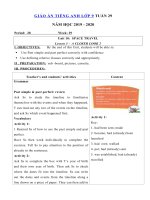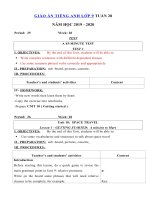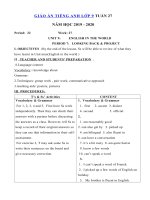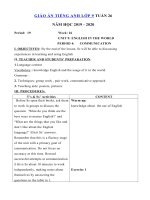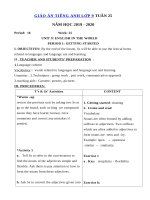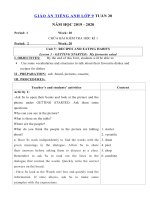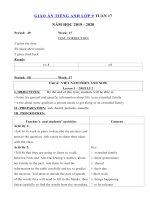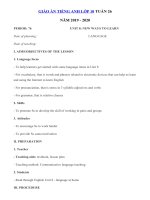Tải Giáo án tiếng Anh lớp 9 Tuần 21 sách mới - Giáo án điện tử môn tiếng Anh 9 theo tuần
Bạn đang xem bản rút gọn của tài liệu. Xem và tải ngay bản đầy đủ của tài liệu tại đây (133.54 KB, 7 trang )
<span class='text_page_counter'>(1)</span><div class='page_container' data-page=1>
<b>GIÁO ÁN TIẾNG ANH LỚP 9 </b>
<b> TUẦN 21</b>
<b>NĂM HỌC 2019 - 2020</b>
<b>Period: 4 Week: 21</b>
<b>Unit 7: RECIPES AND EATING HABITS</b>
<i><b>Lesson 3 - A CLOSER LOOK 2</b></i>
<b>I. OBJECTIVES: By the end of this Unit, students will be able to:</b>
use some quantifiers correctly write and use conditional sentences type 1 with modal verbs
<b>II . PREPARATION: sub -board, pictures, cassette </b>
<b>III. PROCEDURES: </b>
<b>Teacher’s and students’ activities</b> <b>Content</b>
<b>Activity 1: </b>
- Ask Ss about the use of the four quantifiers. Make
any necessary comments. Have Ss do this exercise
individually and then compare their answers in
pairs.
- Tell Ss that when talking about recipes people
usually use food quantifiers and that the Look out!
Box contains the most common ones.
- Have Ss read the information in the Look out! box.
Explain any unclear points. If time allows, ask Ss to
give examples with the quantifiers. Ss may also add
some more food quantifiers they know to the list.
<b>Activity 2:</b>
- Have Ss do the exercise individually and then
compare their answers with a partner. Remind them
that some quantifiers can go with more than one
noun. Check the answers as a class.
1. a
2. a
3. some
4. some/any
5. a
6. some
7. an
8. any
9. some
</div>
<span class='text_page_counter'>(2)</span><div class='page_container' data-page=2>
<b>Activity 3:</b>
a/ Have Ss work in pairs to read the instructions to
make a chicken salad and to ll each blank with a
word/phrase from the box. Check as a class.
b/ Ask Ss to work in pairs, and think about a simple
salad they know. Together Ss write the instructions
to make it. Call on some pairs to read aloud their
instructions. Other Ss listen, make comments, and
vote for the best salad.
- T may also organise a competition. Have Ss work
in groups to write the instructions to make a salad
on a big piece of paper. Once they have finished,
each group sticks their instructions on the board. A
board of five Ss act as examiners. This board reads
the instructions and gives each group a mark.
<b>Activity 4:</b>
- Have Ss read the two given sentences and answer
the questions. Elicit their answers and confirm the
correct ones.
- Ask them to give the standard form of conditional
sentences type 1. T may call on one student to write
the form on the board. Now have Ss read the
information and examples in the grammar box.
Write the form of the examples on the board:
If + S + V (present simple), S +
can/must/may/might/should + V (infinitive).
<b>Activity 5:</b>
- Have Ss do the exercise individually and then
compare their answers in pairs. Ask some Ss to read
out loud the complete sentences.
1. 200 grams 2. an
3. tablespoons 4. teaspoon
5. teaspoon 6. some
1. ability
2. advice
</div>
<span class='text_page_counter'>(3)</span><div class='page_container' data-page=3>
<b>Activity 6:</b>
- Have Ss work in pairs to read the situations and
<i>write appropriate if-sentences. Call on some Ss to</i>
write their sentences on the board. Give necessary
correction.
If time allows, organise a quick game. Ss work in
groups and write down two situations. After five
minutes, have a representative from one group stand
up and read out one situation. This student points at
a random student in another group to give a
conditional sentence type 1 with a modal verb. If the
sentence is correct, the group gets one point. The
groups take turns to read their situations. The
winner is the group with the most points. Make sure
the groups have equal opportunities to give the
answers.
1. If you want to have good health,
you must reduce the amount of salt
in your food.
2. If my brother is hungry, he can
eat three bowls of rice.
3. You can take a cooking class if it
is at the weekend.
4. If I eat this undercooked pork, I
may have a stomachache.
5. You should whisk the eggs for 10
minutes if you want a lighter cake.
<b>IV- HOMEWORK:</b>
-Write new words then learn them by heart.
-Copy the exercise into notebooks.
<b>-Prepare COMMUNICATION</b>
<b>Period: 5 </b> <b>Week: 21</b>
<b>Unit 7: RECIPES AND EATING HABITS</b>
<i><b>Lesson 4 - COMMUNICATION</b></i>
<b>I. OBJECTIVES: By the end of this Unit, students will be able to:</b>
discuss the recipe for a dish</div>
<span class='text_page_counter'>(4)</span><div class='page_container' data-page=4>
<b>Teacher’s and students’ activities</b> <b>Content</b>
<b>Activity 1: </b>
- Have Ss look at the picture and answer the
questions. Quickly elicit their answers and write
them on the board. Do not confirm the correct
answers now.
<b>Activity 2:</b>
a/ Play the first part of the recording for Ss to check
their answers. Confirm the correct ones.
b/ Play the recording again for Ss to do the exercise.
Have them compare their answers in pairs. Call on
two Ss to write their answers on the board. Ask
other Ss to correct these answers if needed. Play the
recording one more time for Ss to check their
answers.
<b>Activity 3:</b>
- Have Ss read the steps to cook the soup and try to
rearrange the steps. Ask some Ss to write their order
on the board. Play the recording for Ss to check
their answers. Ask Ss to comment on the orders on
the board. If there are any unclear points, play the
recording a second time.
- Without playing the recording again, ask Ss about
the benefits of the soup. If Ss are not sure about any
points, play the recording again. Have one student
talk about the benefits.
<b>Activity 4:</b>
a/ Have Ss work in groups to discuss a dish they
like. Ss take notes of the ingredients, how to prepare
the dish, and the steps to cook it on a big piece of
1. pumpkin, celery, shallots, butter,
salt, cream
1. a kilo/one kilo 2. two
3. two sticks 4. two
tablespoons
5. two tablespoons 6. a pinch
7. peel 8. chop
9. peel 10. slice
11. leaves
1. b
2. e
3. f
4. c
5. a
6. d
</div>
<span class='text_page_counter'>(5)</span><div class='page_container' data-page=5>
paper. Move around to provide any necessary help.
b/ Ask groups to stick their answers on the walls
around the class. Ask other Ss to move around to
each group and listen to the group’s presentation
about the dish. Have Ss vote for the best dish and
explain the reasons.
<b>IV- HOMEWORK:</b>
-Write new words then learn them by heart.
-Copy the exercise into notebooks.
<b>-Prepare SKILLS 1</b>
<b>Period: 6 Week: 21</b>
<b>Unit 7: RECIPES AND EATING HABITS</b>
<i><b>Lesson 5 - SKILLS 1 </b></i>
<b>I. OBJECTIVES: By the end of this Unit, students will be able to:</b>
read for general and specific information about the eating habits of Japanesepeople
talk about the eating habits of Vietnamese people
<b>II . PREPARATION: sub -board, pictures, cassette </b>
<b>III. PROCEDURES: </b>
<b>Teacher’s and students’ activities</b> <b>Content</b>
<b>Activity 1: </b>
Have Ss work in pairs to discuss the questions.
Elicit their answers. Because it is an open activity,
accept different answers.
<b>Activity 2:</b>
Ask Ss to read the headings quickly. Make sure they
understand the meaning of each heading.
Now Ss read the paragraphs and match them with
the headings. Ask them to compare their answers
Picture A: different types of sushi
Picture B: miso soup
Picture C: a bowl of rice
Picture D: sliced cucumber/pickled
cucumber
</div>
<span class='text_page_counter'>(6)</span><div class='page_container' data-page=6>
with a classmate. Elicit their answers.
<b>Activity 3:</b>
Have Ss read the article again to answer the
questions. Ss can underline parts of the text that
help them with the answers. Ask Ss to compare their
answers before giving the answers to T. Ask them to
give evidence when giving the answers.
<b>Speaking</b>
This part helps Ss understand more about the eating
habits of Vietnamese people.
<b>Activity 4:</b>
- Have Ss work in groups to discuss the eating
habits of Vietnamese people. Ss use the questions
provided as cues. Move around the class to provide
help. Ask the groups to organise their ideas to
prepare for a short presentation.
<b>Activity 5:</b>
Have one group of Ss act as examiners and other
groups as competitors. The groups take turns to
present their ideas. If there is not much time left,
allow about two or three groups to present. Invite
comments from the examiners. Give additional
comments.
1. They like raw food and do not use
sauces with a strong flavour.
2. They cut fresh fish.
3. Both can be served with soy
sauce.
4. There are four (rice, miso soup,
main dish(es), pickles).
5. Rice is the staple food and is very
nutritious.
6. Because the dishes are presented
in different bowls and plates, and
are arranged carefully according to a
traditional pattern.
<b>IV- HOMEWORK:</b>
-Write new words then learn them by heart.
-Copy the exercise into notebooks.
<b>-Prepare SKILLS 2</b>
Mời bạn đọc tham khảo thêm tài liệu Tiếng Anh lớp 9 tại đây:
</div>
<span class='text_page_counter'>(7)</span><div class='page_container' data-page=7>
Bài tập Tiếng Anh lớp 9 nâng cao:
</div>
<!--links-->
Tải Giáo án tiếng Anh lớp 9 Tuần 30 sách mới - Giáo án điện tử môn tiếng Anh 9 theo tuần
- 6
- 30
- 0

